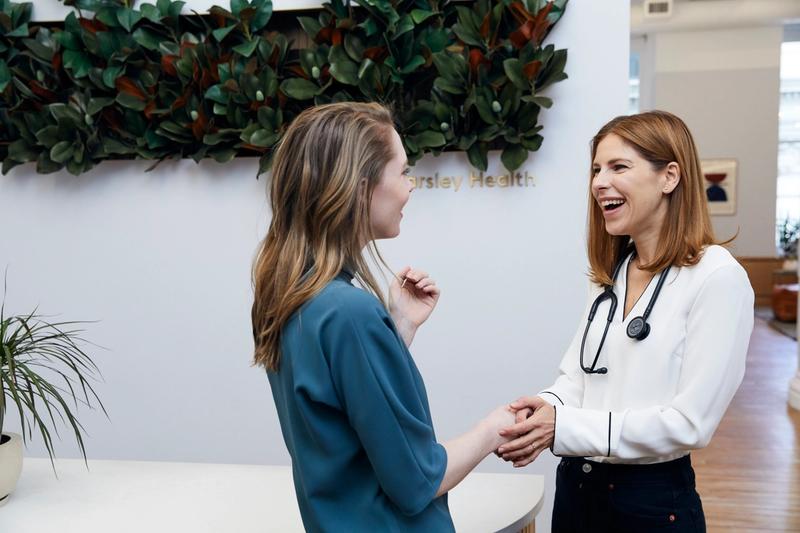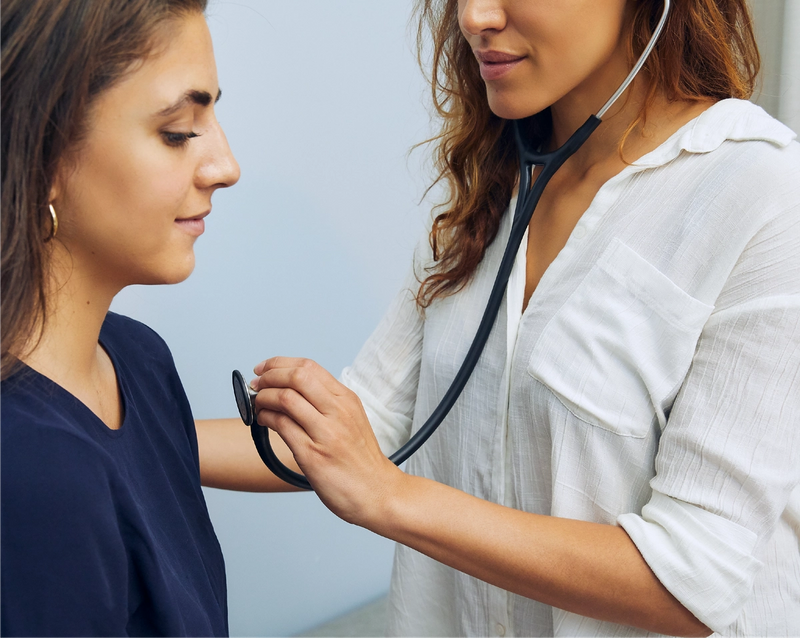5 Things Your Doctor Can Learn Just By Looking at You
Your doctor can tell a lot just by looking at you. Just how much? So much that our doctors have built an entire examination around it, no hopping up on an exam table required.
At Parsley Health, we are proudly now providing our members with an exclusively online membership experience—Complete Care Anywhere —where all doctor and health coach visits take place via video. Regardless of where you live, you can still work with our clinical team. Our Complete Care Anywhere members receive the same holistic care they would with an in-center membership, including advanced diagnostic testing and a personalized health plan. The only difference? They get to do it all from the comfort of their own home.
You might be thinking but wait, how does a doctor evaluate a patient without a physical exam? We’ve thought of that too. To account for this shift in the doctor-patient experience, we’ve created avisual exam that allows for a comprehensive physical to take place right through the screen.
Here’s what our doctors look for during online visits and how Complete Care Anywhere still gives you the personalized touch you’re looking for.
How is an exam performed during an online visit?
As a Complete Care Anywhere member, you spend 60 minutes with your doctor during your initial visit— that’s four times longer than the 15 minutes per year the average person spends with their physician. During this visit, your Parsley Health doctor will map your health biography, design a personalized health plan just for you, and spend about 5 to 10 minutes of your visit time performing a visual assessment.
During the visual exam, your doctor will ask you to move closer to the computer so they can more clearly examine things like your eyes, tongue, and fingernails through the camera.
The best care treats the whole person and is grounded in prevention, not prescriptions and procedures. Get holistic care from anywhere with Parsley Health.
Visual indicators of health your doctor will look for
Your eyes
By getting close to the computer camera and sitting still with your eyes wide, your doctor will take a moment to examine the external eye area, pupil, iris, and sclera—the white outer layer of your eyeball. A noticeable eye twitch or spasm is usually a good indicator that someone is under high stress while super dry and worn skin around the eyelid is likely to indicate an active allergic response.
Generally, irritated and red eyes might indicate a lack of sleep while tearing eyes or eyes with broken blood vessels may indicate strain from too much screen use or excessive coughing and vomiting. More seriously, eyes that appear yellow or jaundice—a condition that occurs when too much bilirubin, the yellow compound formed from the breakdown of red blood cells, is in your blood— is typically due to an issue in the liver such as hepatitis or a blockage of the bile ducts.
Your tongue
Believe it or not, “you can learn a lot from someone’s tongue,” says Carolyn Krieg, DO , a virtual doctor at Parsley Health. “Scalloping of the tongue—or indented or rippled edges along the sides of the tongue—may indicate an increased likelihood of food sensitivities or leaky gut ,” Krieg says. Additionally, tongue scalloping may even be a clue to look for other underlying medical conditions such as sleep apnea, autoimmunity, or hypothyroidism .
Beyond that, “if a patient’s tongue is generally swollen, inflamed, or reddened, I might suspect some type of B vitamin deficiency, ” noted Michael Zielinski, DO , another virtual doctor at Parsley Health. Glossitis— or inflammation of the tongue—is a known sign of both vitamin B6 and vitamin B12 deficiencies.
Your neck
Next, your doctor will ask you to turn your head side to side to assess your neck’s range of motion. To help ensure they can see the anatomy of the neck and shoulders clearly, your doctor may ask you to remove a scarf or any clothing blocking their view. Our doctors check for anything that might seem out of the ordinary in the head and neck region including noticeable bumps, lumps, asymmetry, swelling, discoloration, or bruising. If you have swollen lymph nodes, for example, this may be an indication of an ongoing infection or an activated immune system .
Your nails
They’ll also ask you to put your hands in front of the camera for visual inspection of your fingernails. “If I see peeling, cracking, or ridging in the fingernails, I suspect to see nutritional deficiencies in my patient’s labs,” says Krieg, “it helps to give me a good idea of what their nutrient status might look like even before we have the results back.” Specifically, Dr. Zielinski notes that the fingernails often tell him about copper, zinc, and protein status of a patient. “White spots appearing on the fingernails, for example, may be associated with a zinc deficiency or indicate an issue in the normal zinc to copper relationship in the body,” he says. Dr. Zielinski admits, “If I see something going on with the fingernails, I might even ask the patients to take their shoes off so I can assess their toenails, too.” The more information gathered through the visual exam, the better.
Your skin
Lastly, our virtual doctors ask patients about skin issues and examine notable problem areas such as facial acne , skin rashes, eczema , and psoriasis patches. If they have trouble seeing the fine details of a skin lesion, they’ll simply ask their patients to send them high quality pictures of the area from their phone via email for a better look— something many of our in-person members do regularly already.
The benefits of an at-home visual exam
While we’re naturally used to the comfort of receiving a physical exam from a doctor to make sure “everything looks good,” several recent studies have highlighted the overall deterioration in in-person physical examination skills amongst modern physicians. “The funny thing is,” notes Dr. Zielinski, “the thorough visual examination we give our members in an online visit, such as looking at their tongue and fingernails, patients often say they’ve never even received in a typical in-person primary care visit.” It’s also the same type of exam Parsley Health members receive when they visit a doctor in-person.
Similarly, while our doctors are unable to measure blood pressure during a video visit, our virtual doctors noted this as a strength rather than a weakness. This is because studies have consistently shown substantial differences in blood pressure when measured outside versus in the medical office setting, a phenomenon accurately named “white coat hypertension.”
“For blood pressure, I actually prefer receiving at-home monitoring from patients with high blood pressure to prevent false readings associated with white coat hypertension,” says Dr. Krieg. With blood pressure cuffs readily available for consumers, patients are able to reliably and consistently check their blood pressure in the comfort of their own home and provide long-term patterns in blood pressure rather than a single, potentially inaccurate, data point. Even the American Heart Association recommends at-home blood pressure monitoring for all people with hypertension to help healthcare providers determine whether treatments are working.
Ultimately, if we really want to reimagine what the best possible medicine looks like, we have to be open to shifting what an appointment with our doctor looks like. While we may think about a physical examination as a key element of a doctor’s visit, the bigger benefit you receive with a Complete Care Anywhere membership is getting to spend more time with your physician, deep diving into your personal medical history, and establishing a longitudinal relationship with a doctor who truly knows you. Whether you see us online or in-person, we are confident that the care you receive at Parsley Health will be comprehensive, holistic, and science-based.
Kelly Candela is a registered Dietitian Nutritionist with six years of experience in the health and wellness field, four of which have been spent right here at Parsley Health supporting members with everything from gut issues and autoimmune disease to cardiometabolic health concerns and fertility. She holds a Master's of Science in Nutrition from one of the leading science-based natural medicine schools in the country, Bastyr University, and completed her dietetic internship at Sea Mar Community Health Center in Seattle, WA.
Get a snapshot of your health - right now.
Take our quiz to get your symptom score and start uncovering the why behind your symptoms.
WHAT IS PARSLEY HEALTH?
Our leading medical providers and health coaches heal the root cause of health concerns with a personalized care plan and year-round support. Our root-cause resolution medicine has helped thousands feel better, with 85% of members reducing symptoms in their first year.

